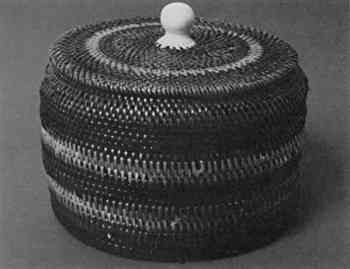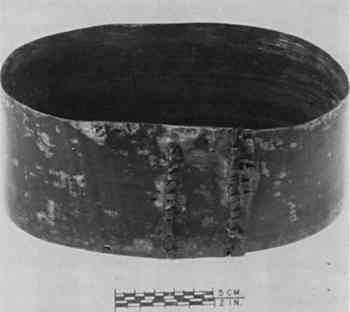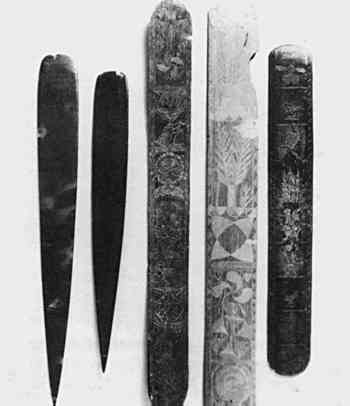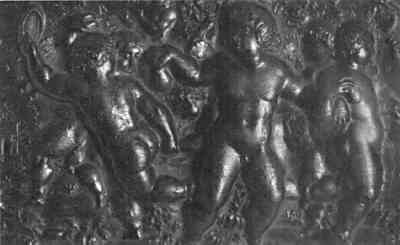BALEEN IN MUSEUM COLLECTIONS: ITS SOURCES, USES, AND IDENTIFICATIONJULIE A. LAUFFENBURGER
3 HISTORIC USES OF BALEEN3.1 ALASKA NATIVESBaleen emerged as a useful by-product of the whaling industry in many cultures and societies. Its thermoplastic nature and enormous strength allowed it to fulfill many functional and decorative roles. In the Arctic communities of northwest Alaska, whaling was central to the way of life as early as 1000 A.D. (O'Connor 1987). The Inuit of Alaska hunted whales in the spring amid great ritual and ceremony. They concentrated primarily on the bowhead whale, a baleen whale that spent its entire life cycle in polar waters. The Inuit made use of all their resources, and baleen was not overlooked. Prior to European and American influences, baleen traditionally was worked by the men of these communities, whose job it was to work the so-called “hard materials.” This tradition continued until this century. Baleen was easily removed from the gum of a dying whale while the plates were still elastic and flexible. As it dried it became hard and inflexible. In order to be worked, baleen was cut into sizes appropriate for use. Baleen basketry of a particular type developed in the regions of Barrow, Point Hope, and Wainwright, Alaska, sometime after the decline of Yankee whaling around 1914 (fig. 8). The first documented example of this basketry, based on a willow-root prototype, was made for Yankee whaler and Barrow resident Charles D. Brower (Lee 1983). Early in the development of the craft, few people were making baskets; each had a distinctive style and working method. Baskets were often signed on the bottom with the name of the artist and the town where they were made. Sometimes a combination of vertical, diagonal, and horizontal lines used for property marks was added.
In order to make baskets of this type, strips of baleen were laboriously trimmed and polished into a flat or rounded contour by applying pressure to the strip with a sharp implement. Throughout the weaving process, the baleen strips were soaked in water so that they remained moist and flexible. Perfectly symmetrical wefts were also produced by drawing strips of baleen through a steel draw plate (Lee 1983). The baleen strips were then woven through a perforated starter disc at the base of the basket; the disc was often made of bone or walrus ivory. Such a basket could take from days to months to complete, depending on the quality of the woven wefts and rods. The completed baskets were sold directly to visitors or itinerant traders or at locally owned stores (Lee 1983). Contemporary basket makers in the region have shortened the time-consuming polishing process and have instead applied mineral oil or an aerosol varnish to the finished wefts and rods. Today, objects such as letter openers, small decoratively inscribed plates, model boats, and toys are still made of baleen for the tourist market. Baleen had other functional uses. Because it did not collect frost, it was especially useful for objects such as fishing line and snares, which required strength and flexibility and were necessary for subsistence fishing and trapping. Baleen hairs were used as bow
3.2 EUROPEAN AND AMERICAN USESWhaling in Europe and the Americas was driven by current market demands. The primary products of the whaling industry were whale oil and whale meat, which was commonly processed into meal, feed, or fertilizer. Early on, baleen comprised only a small portion of the useful by-products. According to written records, baleen plates were first imported into England quite by accident in 1594 when a Biscayan ship wrecked off the coast and the cargo drifted to shore (Stevenson 1907). Bone spades, made of steel, were used to harvest baleen plates from the whale's mouth. After the plates were removed from the gum, they were scraped clean, sorted, and stacked according to color, size, and quality before awaiting their final destination. In the American industry, baleen was delivered to factories in Boston and New York bundled into groups of 15 to 25 individual plates. Because the plates are not uniform, areas on an individual plate were selected for specific purposes. The intended function of each section depended on the flexibility of the baleen in each area and the probability of splitting it along straight lines. According to Stevenson (1907), in order to make the baleen workable, the plates were soaked in tepid water for one to two weeks and then placed in a steam box for 40 to 60 minutes. In the 1590s, the introduction of the farthingale, a hooped petticoat stiffened by strips of baleen, was the primary reason for the increased market for baleen in Europe (Stevenson 1907). In the 18th and 19th centuries baleen continued to play a role in women's fashions. The staybusk, a wide flat strip inserted into the front of a corset to prevent a woman from leaning forward and having bad posture, and strips of dress bone or corset bone made of baleen were advertised in catalogs of the period. Gray whale baleen was most commonly used for dress bone because of its light cream color. The staybusk usually was produced by seamen as a form of folk art for their wives and girlfriends at home. Several fine, elaborately incised examples of staybusks are found in the collection of the Kendall Whaling Museum in Sharon, Massachussetts (fig. 10). Sailors also used baleen to make sewing
The harvesting of baleen became the focus of the whaling industry after 1875, when the use of mineral oil lessened the need for whale oils. In about 1848, during the peak consumption years of baleen, Yankee whaling moved to the Arctic and focused on the bowhead whale. The bowhead was especially prized for its large jaw, which holds up to 700 12-ft baleen plates weighing in the neighborhood of 3,500 lbs (Lee 1983). At the peak of the market for baleen, the amount harvested from just one whale could pay for the expenses of an entire voyage (Matthews 1968, 236). Prices of baleen varied dramatically, from $5.00 per pound in 1907 to $0.075 in 1912 (Lee 1983). In the 19th century baleen was an important raw material comparable to present-day plastics. Second only to its popularity in the fashion industry was its common use by the brush industry for bristles. In the 19th century the British obtained a patent for the manufacture of baleen brushes, and until the introduction of synthetic fibers the brush industry remained one of the major consumers of baleen (MacGregor 1985). In the 20th century baleen was eventually replaced with spring steel and plastics, but not before it had been used for a multitude of functions (table 1). Even the fibrous waste was preferred over horsehair for sofa or chair stuffing. TABLE 1. HISTORIC USES OF BALEEN One particularly interesting object made of baleen in the collection of the Kendall Whaling Museum is a bas-relief panel made from pressed and carved baleen (fig. 11). The panel, entitled The Bacchanalian Frolic, was made by a Dutch artisan, Jan Lutma the Elder, and Jan Osborn, an Englishman working in Amsterdam. The panel is dated to ca. 1618–41, Amsterdam. In 1618 the Dutch North Sea Company granted the two men a patent to produce decorative baleen panels. Their endeavor was short lived and did not enjoy much success, but some of their work survived. The panel in the Kendall Whaling Museum simulates the ebony panels inserted into Dutch furniture of the time and was made as follows:
3.3 JAPANESE USESSimilar to the Inuit whaling industry, Japanese whaling was founded on great tradition and ceremony. In the early 17th century, whaling became an organized industry in Japan. Before then the Japanese caught stray whales that had run aground or mistakenly wandered into bays. A scroll dated 1760 from the Kendall Whaling Museum, titled “Fourteen Varieties of Whales,” indicates that the Japanese had extensive knowledge about whale species and identifies with illustrations 14 different whales. In the early years of the whaling industry, the Japanese focused on the right whale, which resided in coastal waters. The scroll specifically identifies the portions of the whale that the Japanese used, and in several cases plates of baleen are clearly illustrated. One may assume that because of its strong, flexible nature, baleen undoubtedly served many of the same functional purposes in Japan as it did in the West, though because of cultural differences in clothing, the demand for baleen may not have been as driven by the fashion industry. Little is written in English regarding the Japanese use of baleen, but it is commonly known that baleen was used to make novelties such as shoehorns and tea trays (Matthews 1968). Stevenson notes that around the turn of the century in the United States, “very thin baleen strips, about a millimeter in diameter, were employed to a small extent for winding on ornamental sword hilts; this use however is more popular in Japan than in this country” (Stevenson 1907). Even today, baleen is preferred over modern plastics or spring steel as springs in the heads of the puppets of the National Bunraku Puppet Theater of Japan. |



